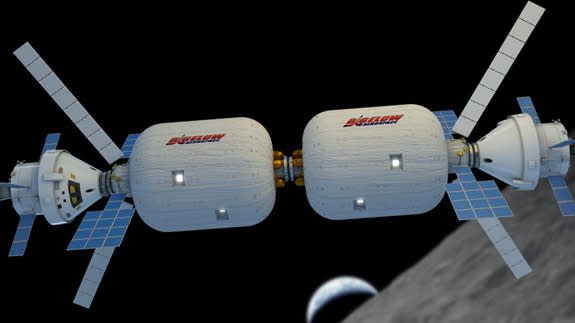The International Space Station could get its own timeshare by 2020

COLORADO SPRINGS — By 2020 at least one part of the International Space Station could become a “timeshare.”
United Launch Alliance — itself a partnership between Boeing and Lockheed Martin — and Bigelow Aerospace are currently collaborating on how to launch a habitat the size of a small apartment to space in about the next four years.
The habitat, which is called the B330 and has about 330 cubic meters of living space, could either be attached to the ISS or float freely as its own autonomous space station, according to Robert Bigelow, founder and president of Bigelow Aerospace.
SEE ALSO: New NASA timelapse shows Earth's horizon from the ISS
The habitat would potentially serve as a test bed for industry partners and science organizations interesting in launching experiments to space.
“Our hope is that NASA would be the primary customer for that structure, and that we would be given permission to commercialize and, essentially, we would be time-sharing,” Bigelow said here at the National Space Symposium during a press conference.
“And how exciting is that? A timeshare in space? Come on,” ULA president and CEO Tory Bruno added.
The B330 could also be a destination for short-stay tourists hoping to get a taste of what life is like in space.
“If we were flying a cargo mission, then we could accommodate an amateur astronaut or two,” Bigelow said.
“There are scenarios where it could be a week or two, and there are scenarios where it could be 45 days or 60 days and this would be applicable to if it were on station or if it were a free-flyer, we’d have more latitude to accommodate these kinds of things.”
And Bigelow would even love to see famous companies brand their own space stations.
"We would love to see Disney have a Disney space station," Bigelow said.
ULA hopes to launch the B330s using its Atlas V rocket, though the partnership between the two companies is, in part, designed to asses the feasibility of that plan.
Launching to the ISS is more than just a pipe dream for Bigelow.
A Bigelow module called the Bigelow Expandable Activity Module (BEAM) arrived at the ISS aboard SpaceX’s Dragon craft that made it to the Space Station this weekend.
That module, which contains enough room for a person to float around in, will be deployed on the outside of the station, creating a little more room for astronauts to roam and perform experiments in.
The BEAM will help the company prove out the technology needed to maintain inflatable structures in space.
Of course, the details of Bigelow’s actual plan for the B330 are still pretty light.
The company doesn’t yet have a launch contract with ULA, and in order to attach the habitat to the ISS, they will need permission from NASA and a partnership with the space agency.
Bigelow and ULA were also very tight-lipped about any industry or international partners they are hoping to court with dreams of a habitat in space of their very own.
Both Bigelow and Bruno see their partnership as a major step toward “democratizing space,” making spaceflight capabilities available to more people than ever before.
In an ideal world, Bigelow will be able to make B330s available to companies and scientists interested in having their own space stations a couple hundred miles above the Earth.
The company is also hoping to use private crafts built by Boeing, Sierra Nevada Corporation, SpaceX and Blue Origin to fly to and from the B330s, potentially bolstering the blooming commercial space industry in the coming decades.
“This innovative and game-changing advance will dramatically increase opportunities for space research in fields like materials, medicine and biology,” Bruno said in a statement.
“And it enables destinations in space for countries, corporations and even individuals far beyond what is available today, effectively democratizing space. We can’t begin to imagine the future potential of affordable real estate in space.”

